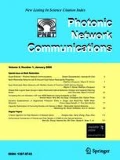The 14th International Conference on Optical Communications and Networks—IEEE ICOCN 2015 (http://icocn2015.nuaa.edu.cn/Default.asp)—was held in Nanjing during July 3–5, 2015.
IEEE ICOCN aims to provide a premier opportunity for professionals, experts, engineers, scientists, and industrial people worldwide in the field of research, development and applications of photonics to share and exchange their experience. IEEE ICOCN 2015 included four technical tracks: (1) photonic devices and integration, (2) optical networks and transmission systems, (3) microwave photonics and analog optical systems, and (4) fiber optics, fiber devices and optical sensing.
IEEE ICOCN 2015 was a 3-day event organized by Nanjing University of Aeronautics and Astronautics, Najing University and Najing University of Posts and Telecommunications, and was technically sponsored by IEEE Photonics Society. The conference was also supported by KEYSIGHT Technologies, ROHDE & SCHWARZ, Jiangsu Society of Aeronautics and Astronautics, Nanjing Society of Optical Communications and Photonic Technology, Luster LightTech Group, and Conquer Company.
We accepted more than 217 papers by the authors from more than 18 countries and regions, among which 70 are invited talks. All the papers were carefully reviewed by more than 60 Technical Program Committee (TPC) members and external reviewers, with each paper evaluated by at least two reviewers. All these papers and talks are organized into eight lecture-style oral sessions and one interactive poster session.
Based on the comments received from the reviewers, the authors of ten accepted papers that are in the area of optical networking were invited to submit an extended version of their work for possible publication in this Optical Networking Special Issue of the Springer Photonic Network Communications (PNET) journal. After a thorough review process, eight papers have been selected for publication. In addition, this Special Issue includes invited papers that went through the same review process of the other accepted papers. A brief summary on the accepted papers is provided next.
In “An area coverage algorithm for non-line-of-sight ultraviolet communication network”, T. Zhao, Y. Gao, and Y. Zhang propose a graded area coverage optimization algorithm based on genetic algorithm (GACOA) to reduce the deployment cost of network and enhance the area coverage of network in the non-line-of-sight ultraviolet (UV) communication. It is demonstrated that GACOA outperforms the traditional approaches in the same UV network.
In “Cognitive algorithm using fuzzy reasoning for software-defined optical network”, T. R. Tronco, M. Garrich, A. C. César, and M. de Lacerda Rocha propose a cognitive algorithm based on Fuzzy C-Means (FCM) technique for the software-defined optical networks (SDONs). In order to achieve a better network performance, the authors add the FCM algorithm to the SDON control plane. Compared to the case-based reasoning (CBR) algorithm, FCM outperforms CBR in both fastness and error avoidance, achieving 100 % of successful classifications and faster in two orders of magnitude.
In “A 3D multilayer optical network on chip based on mesh topology”, K. Zhu, H. Gu, Y. Yang, W. Tan, and B. Zhang propose a 3D multilayer optical network on chip (3D MONoC) based on Votex, a non-blocking optical router with seven ports, to realize 3D interconnection with smaller area and lower cost of OnoC. A comparison of 3D MONoC employing Votex with its 2D counterpart is made to show that the proposed architecture improves the performance.
In “Power-aware virtual optical network provisioning in flexible bandwidth optical networks”, B. Chen proposes the power-aware virtual-links mapping (PVLM) approach and the power-aware virtual-nodes mapping (PVNM) approach for a given set of virtual optical networks in flexible bandwidth optical networks with the distributed data centers, aiming to greatly reduce the power consumption and save the spectrum resources.
In “Joint wireless and optical resources allocation for availability-guaranteed service in survivable fiber-wireless access network”, Y. Liu, Y. Yu, and P. Han study the resource allocation for availability-guaranteed service in a survivable FiWi access network. A novel model is established to estimate the connection availability of service demand and a new approach for joint wireless and optical resources allocation is proposed to provide the availability-guaranteed service. Numerical results demonstrate that the proposed scheme can reduce the resource consumption significantly.
In “Evaluations for transponder utilizations of two active-standby banks in CD-ROADM optical networks with traffic grooming”, D. Wang, M. Zhu, J. Zhang, and X. Sun propose an integer linear programming model and an efficient heuristic algorithm to optimize the TP bank configurations in colorless and directionless reconfigurable optical add/drop multiplexer (CD-ROADM) optical networks.
In “Experimental demonstration of software-defined optical network for heterogeneous packet and optical networks”, Y. Zhou, S. Yin, B. Guo, H. Huang, W. Li, M. Zhang, and S. Huang propose a control architecture for packet and optical network convergence toward software-defined optical network (SDON), aiming to be compatible with the existing optical network control architecture. Experimental results validate that the proposed control architecture is effective in improving service provisioning time and blocking probability.
In “A novel combined channel estimation algorithm for elastic optical networks”, F. Meng, X. Gong, and J. Wu design an identified channel estimation algorithm called combined channel estimation algorithm (CCEA), which integrates the improved discrete Fourier transformation and wavelet threshold de-noising method. The proposed algorithm ensures the reliable and long-distance signal transmission for the elastic optical networks (EONs).
IEEE ICOCN 2015 Optical Networks Subcommittee Co-Chairs
Lei Guo, Northeastern University, P. R. China, haveball@163.com
Hoon Kim, Korea Advanced Institute of Science and Technology, Korea, hoonkim@kaist.ac.kr
Alan Pak Tao Lau, Hong Kong Polytechnic University, Hong Kong, alan.pt.lau@polyu.edu.hk
IEEE ICOCN 2015 General TPC Chair
Shilong Pan, Nanjing University of Aeronautics and Astronautics, P. R. China, pans@nuaa.edu.cn
Author information
Authors and Affiliations
Corresponding author
Rights and permissions
About this article
Cite this article
Guo, L., Kim, H., Lau, A.P.T. et al. Optical networking special issue based on selected IEEE ICOCN 2015 papers. Photon Netw Commun 32, 266–268 (2016). https://doi.org/10.1007/s11107-016-0662-z
Published:
Issue Date:
DOI: https://doi.org/10.1007/s11107-016-0662-z

